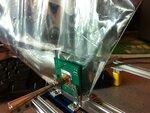ccarrot
Newbie level 6
Hi everyone:
I have two coils designed in order to transmit squared pulses. They are standing face to face with distance of 10mm. The attenuation of received signal is supposed and tested to be -20dB in air, when I place a bag of salt water in between, the attenuation became to be about -12dB, that is, the coupled signal "increases" when in the water.
In my mind, the salt water will absorb such signal resulting in more attenuation; but it is not in practical test. I don't know how to explain this. The frequency band of such received signal lies in 100-300MHz.
This is the test setup:

This is the result:
View attachment airwater.pdf
Could anyone help me to explain this? Is there anything that I've ignored in the test and made mistakes? Thanks in advance!
I have two coils designed in order to transmit squared pulses. They are standing face to face with distance of 10mm. The attenuation of received signal is supposed and tested to be -20dB in air, when I place a bag of salt water in between, the attenuation became to be about -12dB, that is, the coupled signal "increases" when in the water.
In my mind, the salt water will absorb such signal resulting in more attenuation; but it is not in practical test. I don't know how to explain this. The frequency band of such received signal lies in 100-300MHz.
This is the test setup:

This is the result:
View attachment airwater.pdf
Could anyone help me to explain this? Is there anything that I've ignored in the test and made mistakes? Thanks in advance!